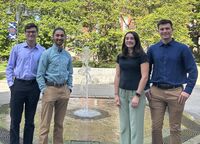V25B-Wells
This page is an overview of the V25B-Wells Project
 The V25B Wells Team | |
| Team Members | |
|---|---|
| From Left to Right |
|
| Xander Recca | Robotics Engineer |
| Jeevan Baylis | Mechanical Engineer |
| Victoria Serrambana | Civil Engineer |
| Tanner Smith | Chemical Engineer |
Mission Statement
The goal of this project is to assist WPI's Venice Project Center in continuing research on public fountains and wellheads throughout Venice and the surrounding lagoon. We aim to catalog functionality, location, and condition of these structures into existing databases, such as Venepedia, PreserVenice, and ArcGIS; websites that are accessible to everyone. The information collected will be used to promote the use of public water fountains and raise awareness for restoration efforts.
Objectives
1. Document all wellheads and fountains in Venice, Murano, Burano, and The Lido.
2. Assess the physical condition and operational status of every water structure we find.
3. Capturing, from multiple angles, every wellhead, fountain, and the surrounding area.
4. Upload all Venice wellhead and fountain data to PreserVenice, Venepedia, and ArcGIS.
5. Provide a priority list ranking wellheads and fountains for conservationists or sustainability experts to use.
6. Create a graphic detailing the damage to wellheads and fountains based on location
Introduction
Founded over 1000 years ago, Venice is a city rich with art and culture. It maintains a special identity as a city built on water, specifically in a lagoon in the Adriatic Sea. Its unique location on the sea allows for opportunities and creates problems that other cities do not experience. Boats as the primary form of transportation are the most well known; wells and fountains are also extremely prominent as a source of drinking water due to the surrounding saltwater. These structures *something about bringing culture from the past while also having a functional use*.
In the early years of the city, Venetians used barges to ship water from the mainland. However, this method was expensive and not sustainable for the long-term survival of the city. Venetians developed Cisterns as a means for capturing and filtering rainwater into drinking water. Venetians used the cistern/well system for nearly a thousand years; at its peak, there were estimates of 7000 public and private wells.[1] In the late 1800s, Venice shifted away from wells and towards fountains using a new aqueduct system. Instead of collecting rainwater, the mainland supplied the city with water through a series of pipes.[2] The fountains provided Venetians with a constant, reliable source of water. With the constant progression of technology, many of the fountains have come to the same fate as the wells: unused and neglected.
One of the most pressing issues of today is sustainability and reducing the consumption and disposal of plastic. Each year, manufacturers produce around 450 million tons of plastic globally.[3] Unless properly dealt with, a significant amount of plastic finds its way into the ocean and other natural ecosystems. Reducing plastic use is not a small effort, but grassroots movements can lead to more significant change. Certain groups that are located in Venice, such as Venice Lagoon Plastic Free, are part of this initiative to push for the widespread availability of safe drinking water, specifically via fountains, to reduce plastic bottle consumption.
Our project focuses on documenting public wellheads and fountains through field observations and photographs. We will document the physical condition of the wells, including damage or graffiti. Previous IQPs documented these structures; we will compare our findings with previous documentation to see if and how the condition changed. Our goal is to promote the restoration and reactivation of wellheads and fountains to promote sustainability.
We will use a multitude of methods to aid in the documentation and presentation of the structures. For field work, we will utilize Survey123 to create a standardized list of questions for us to answer and upload pictures for each structure. For the wellheads, we will primarily look at the condition; for the fountains, we will look at the functionality and flow rate. Our sponsor created and uses several websites that we will import our data into: ArcGIS, Venipedia, and PreserVenice. ArcGIS and PreserVenice show information through interactive maps, and Venepedia has a similar layout and function to a website such as Wikipedia but specifically targets Venice.
The long-term goal of restoring and reactivating the structures will extend beyond the scope of our project; completion of this goal depends on external groups and resources. As such, we want to meet with three groups: Masegni e Nizioleti, Venice Tap Water, and Venice Lagoon Plastic Free. The first group targets removing graffiti from Venice; they can aid in the restoration of wellheads through the removal of graffiti. Venice Tap Water and Venice Lagoon Plastic Free are non-profits with the aim of promoting sustainability. Reactivating fountains will encourage people to use refillable water bottles and cut down on plastic waste. We will communicate with these three groups to discuss how our project can aid in their goals.